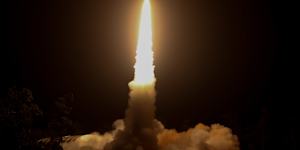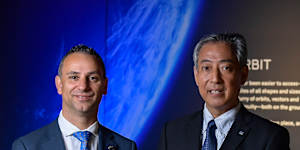The Department of Industry,Science and Resources recouped $77 million in savings in Tuesday’s federal budget by cutting three programs that aimed to support Australian space technology,including $32.3 million slated to co-invest in spaceports and launch sites.

The first NASA rocket launch from a commercial spaceport blasted off from Arnhem Space Centre in the Northern Territory.Equatorial Launch Australia
“It’s a significant cut,” the chief executive of the Space Industry Association of Australia,James Brown,said. “Every country in the world is investing in growing space capability. Only governments can lead that investment,and our government is going in a different direction.”
The axing of the spaceport program in particular was bad news,said senior space policy analyst at the Australian Strategic Policy Institute Dr Malcolm Davis.
“If we’re going to have sovereign space capabilities,which was the goal,then we need somewhere to launch from,” he said.
“Launch is the most dynamic aspect of the Australian space sector. It’s the one that everyone gets excited about. If the government is de-emphasising that,then that kind of[cut] really undermines our competitiveness internationally.”
Australia’s existing spaceports include Arnhem Space Centre,a commercial facility in the Northern Territory NASA launched a rocket last year. Another spaceport planned for Toowoomba in 2024,however,was thrown into doubt last month after satellite launch company Virgin Orbit went bankrupt.
The cuts to space industry support came on the same day the biannual Space Forum was held in Adelaide,where 80 Australian space companies exhibited to 1000 attendees,including the president of Japan’s space agency,Dr Hiroshi Yamakawa.
“For this news to come out on the heels of that is probably not a good signal to send[about] the competence of the sector,” Davis said.
Brown said the space industry was awaiting clarity and confirmation around the $1.2 billion National Space Mission for Earth Observation program announced by the previous government in the March 2022 budget. Detail on the mission was retracted from Tuesday’s budget due to commercial sensitivity.
“That is the most significant public policy development for space in 40 years in Australia,” Brown said. “The industry wants to see some sort of certainty.”

Enrico Palermo,head of the Australian Space Agency and Dr Hiroshi Yamakawa,president of the Japan Aerospace Exploration Agency.Roy Van Der Vegt
A spokesperson for Industry and Science Minister Ed Husic said the next steps of the landmark mission would be announced “in due course”. The department confirmed $43 million of the savings recouped from the space sector were put towards budget repair and the remaining $34 million went to the Australian Space Agency.
The investment in the agency,which has a goal to triple Australia’s space industry to $12 billion and 30,000 jobs by 2030,was just over half the $59.7 million awarded to Canberra’s science museum Questacon. Previous government reports found a small but effective space agency requires at least per year.
Husic’s office said the government’s $15 billion National Reconstruction Fund (NRF) and the $392 million Industry Growth Program would provide future funding opportunities for the space industry.
Brown called for $500 million of funding for the Australian space industry in a submission to the NRF,arguing that the vast majority of weather and climate data,critical for industry and disaster mitigation,came from space.
“The challenge with the NRF is it may be some time before that money actually starts to have an impact,” Brown said. “The thing the space industry needs more than anything else is stability and predictability.”
A compiled by Australia’s spatial industry (which involves Earth observation and satellite technology) and presented to the Australian Space Agency warned the space and spatial industries weren’t growing fast enough to reach the agency’s $12 billion growth goal by 2030.
The report pointed out that,as a proportion of GDP,Australia ranked 21st on space spending despite having the 13th largest economy.
In March,NASA chief Bill Nelson visited Canberra and called for an Australian astronaut to fly with NASA. Nelson privately urged the government to invest more in space,the.
The Morning Edition newsletter is our guide to the day’s most important and interesting stories,analysis and insights..